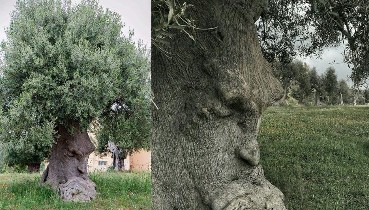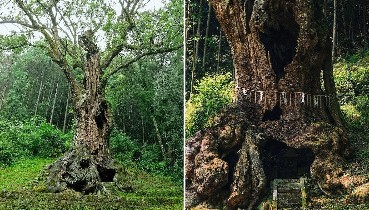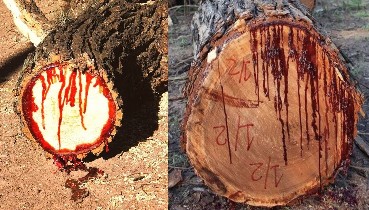

26 Shockingly Bizarre Animals That Came Straight Out Of A Nightmare
Witness the most ugliest, grotesque animals on the planet. Animals that will give you the nightmare of your life! You thought animals were cute? Well, get ready to be proven wrong!!!
1. Naked Mole Rat
Location: Deserts of Kenya, Ethiopia, and Somalia.
One of the most bizarre rodents, populating the deserts of East Africa, is the naked mole-rat. Famed as the longest living rodent in the world, this wrinkly mole rat has a life span of 30 years. With two yellow buck teeth protruding from a pale, hairless body, the mammal may not be an eye-pleaser, but it has an alluring longevity-related adaptation that has gripped researchers in recent years: It seems to be immune to cancer.
2. Red-lipped Batfish
Location – Galapagos Islands
Known for its luscious red lips!, the red lipped batfish is native to the waters of Galapagos Islands. Ironically, it’s a bad swimmer and uses its highly-adapted pectoral fins to walk on the ocean floor. Some scientist believe the purpose of its red bright lip is for the male to attract the female. Yes its the male with the red lips! This fish lives in tropical climates and on the depth range of 3 to 76 meters below sea level and poses no threat as such.
3. Deep Sea Hatchetfish
Location: Oceans around the world especially South and Central America.
This is the kind of creature that came straight out of your nightmare to suck your soul out! But this deep sea fish lives in depths which have little or no light penetration at all. Because of this, their eyes are adapted to recognize even the slightest shadows in the water. Believe it or not, these creatures have the ability to create a light of their own through a phenomenon known as bioluminescence and sometimes they can actually adjust the level of light below them to match the surface light, which makes them practically invisible! Scary indeed!
4. Blob Fish
Location: Deep waters off the coasts of mainland Australia and Tasmania, as well as the waters of New Zealand.
Voted as the world’s ugliest animal, the blob fish is actually a pretty harmless creature…Don’t let the permanent, miserable scowl on its face fool you. Blob fish are found as deep as 300 meters or more, meaning that they can be subject to severe decompression when they are pulled out from the waters to the surface. Blobfish don’t have swim bladders but do have very soft bones. That makes sense for an animal that lives in the crushing pressures of the deep sea, allowing the fish to compress without cracking their bones. But up at the surface the fish seems jellylike and basically collapses, distorting its features.
5. Goblin Shark
Location: Found near the coasts of Japan, the Gulf of Mexico, the Pacific Ocean, and the Atlantic Ocean.
Sometimes referred to as vampire sharks, these creatures don’t like being exposed to sunlight. They aren’t often seen and so some people believe they are very low in numbers. Because of its distorted and disfigured appearance, some people assume this is some type of species that has been born with genetic concerns or that has been mangled by another creature living in the water. Given the depths at which it lives, the goblin shark poses no danger to humans but it might as well be on the endangered list due to few sightings of the shark.
6. Aye – Aye
Location: Madagascar
This grotesque looking creature is the Aye- Aye, native to the island of Madagascar. These creatures are nocturnal i.e. they only come out at night. Aye-ayes spend their lives in rain forest trees and avoid coming down to earth. They have long witch-like fingers that help them grab small insects and grubs from tree trunks. These animals may not look like primates at first, but they are related to chimpanzees, apes, and even humans. Many locals regard the aye -aye as an omen of ill luck. For this reason they have often been killed on sight. Such hunting has made the aye-aye critically endangered, but thankfully they are protected by law.
7. Star-Nosed Mole
Location: Wet low areas of Eastern Canada and the northeastern United States, with records extending along the Atlantic coast as far as extreme southeastern Georgia.
These creatures possess one of the most bizarre noses in the entire animal kingdom. The snouts are lined with more than 25,000 minute sensory receptors that help the mole feel its way through its underground lair. These 11 pairs of pink fleshy appendages ringing its snout is used as a touch organ and are perfectly poised to detect seismic wave vibrations.
8. Frilled Neck Lizard
Location: Found mainly in northern Australia and southern New Guinea.
Known for the peculiar frill around its neck, this lizard is largely arboreal, spending majority of its time in the trees. When the lizard is frightened, it produces a startling deimatic display: it gapes its mouth, exposing a bright pink or yellow lining; it spreads out its frill, displaying bright orange and red scales; raises its body; and sometimes holds its tail above its body. This reaction is used for territorial displays, to discourage predators, and during courtship.
9. The Blue Dragon Nudibranch
Location: Found off the coast of South Africa, Australia and Mozambique.
This strange blue creature may look like a monster from a Japanese RPG, but it actually is a real animal—the Glaucus atlanticus, sea slug, to be exact. Known as the blue dragon, this creature is a is a species of blue sea slug. You could find it in warm waters of the oceans, as it floats on the surface because of a gas-filled sac in its stomach. The blue dragon is an aggressive predator that feeds on organisms much larger than itself, including the venomous Portuguese man o’ war. Not only that, it actually absorbs the man o’ wars venom and stores it in the tips of the finger-like appendages on either side of its body to use when preying on other fish! So small but so vicious.
10. The Saiga Antelope
Location: European and Asian grasslands
The saiga antelope is known for its large distinctive nose, which can flex and inflate to help it breath better in dusty summers and harsh winters of the Kazakhstan. In the summer, its coat is thin and tawny, but in the winter it grows a wooly pelt. The saiga antelope is a major player in one of the most spectacular animal migrations. It faces an uncertain future due to hunting and loss of habitat.
11. Pyura Chilensis
Location: South America (Chile and Peru)
The closest thing to getting blood from a stone! Lurking off the coast of Chile and Peru lives a sea creature that blends in so naturally with the rocks on which it lives. However, if you were to accidentally stand on this living rock it will burst to expose a mass of blood-red hermaphrodite creatures considered a delicacy in the nearby Central American countries. It is born a male before developing female organs which means it can breed with itself. Strange but true.
12. Giant Isopod
Location: Deep waters of Atlantic, Pacific and Indian Oceans
Giant isopods live between 550 to 7020 feet deep, and prefer a mud or clay floor, which they burrow into for shelter. The most scary feauture about them, apart from their bug like appearance, is that they can get really BIG! Their size ranges between 7.5 and 14.2 inches in length, but they can get much bigger: One specimen pulled up with an ROV in 2010 was 2.5 feet long! They also can survive very long without eating. In fact, one giant isopod in Japan went for five years without eating a single bite before dying earlier this year. They are known to bite! But its a small one, harmless. Believe it or not THERE’S A WHOLE ALBUM DEDICATED TO SONGS ABOUT THEM. It’s called Songs About Giant Isopods, and you can listen to it here.
13. Lowland Streaked Tenrec
Location: Madagascar
With their spiky bristles between their fur and distinct black and yellowish stripes, the lowland streaked tenrec mostly resembles a cross between a hedgehog and an oversized bee! Its appearance is even more unusual because of the spiky yellow bristles around their head, but gives them great camouflage while foraging on the forest floor. When a predator is foolish enough to go for the tenrec, it will be sure it gets a mouthful of spiky spines that detach from the tenracs body. This small tenrec is the only mammal known to use stridulation for generating sound – something that’s usually associated with snakes and insects.
14. Japanese Spider Crab
Location: Japan waters
Meet Crabzilla : the Japanese Spider Crab. It is a species of marine crab that has the largest leg span of any arthropod, reaching up to 3.8 m and weighing up to 19 kg. They are the largest known species of crab and may live up to a 100 years. According to legend, they are described as feeding on the bodies of drowned sailors. That could in part be true, but these marine scavengers will eat just about anything they can find. The spider crabs are considered a prized delicacy in many parts of Japan. They are caught using small trawling nets. Harvesting of the crab is forbidden during the spring, because that is when they lay eggs.
15. Shoebill
Location: Tropical east Africa in large swamps from Sudan to Zambia
Also known as Whalehead or Shoe-billed Stork, is a very large stork-like bird. This large stork-like bird gets its name because of the shape of its beak. Even though it was already known to ancient Egyptians and Arabs, the bird was only classified in the 19th century. Shoebill prefers life in tropical dense marshes, swamps and wetlands.It is listed as a vulnerable species, with no more than 8000 birds left in the wild.
16. Atlantic Wolffish
Location: North Atlantic and in other locations around the UK such as the northern North Sea.
What looks like a zombie shark is actually the Atlantic Wolffish. It is a deep sea fish. hence its appearance. It has very large teeth that stick out of its mouth, even when closed, giving it a ferocious appearance. Despite this look, Atlantic Wolffish are not aggressive towards people and are not known to bite people unless they are provoked. Atlantic Wolffish are voracious predators, and the large head, powerful jaws, and large canine teeth are all used to hunt and eat hard-bodied or spiny invertebrates. Their blood contains several natural compounds that prevent it from freezing.
17. Thorn Bug (Umbonia Spinosa)
Location: Native to South America
Thorn bugs have interested people because of their unusual appearances. These deceptive insects, which are related to cicadas and leafhoppers, have developed enlarged and ornate pronotums, which resemble thorns on a branch. Not only does this aid in camouflaging them to look like a part of the plant they’re resting on, but it also discourages predators of both the bugs and the plant from taking a bite from fear of getting pierced.
18. Sea Pig
Location: Found in all the world’s oceans
These animals, known as sea pigs, are in fact a type of sea cucumber. Sea pigs are found in the deepest abyssal depths of the world’s oceans, as far as 3.7 miles under the ocean surface. They are known to eat bits of decaying plant and animal material found in deep sea mud, but are awfully fond of food that has recently fallen from the ocean’s surface, like a whale corpse!
19. Venezuelan Poodle Moth
Location: Venezuela
It is a new species of moth discovered recently in 2009. This new species of alien-looking moth is still poorly explored. Waiting for more info about them!
20. Panda Ant
Location: Known to exist near the coastal regions of Chile.
The Panda Ant is a most unusual species of insect. Their name derives from the obvious resemblance to a panda in its markings. This remarkable insect is not even an ant. The Panda Ant is actually a variety of wingless wasp! Very little is known of this little seen insect. They have been seen to bring down animals as large as cows with only a few dozen stings.
21. Goliath Tiger Fish
Location: Tropical and Subtropical Africa.
There’s a fish that can eat crocodiles!…Its called the Goliath Tiger Fish and it has only 32 teeth. When your name is Goliath, you’d better be one humongous, ferocious creature, and the Goliath tigerfish (Hydrocynus goliath) definitely lives up to its name. It’s the largest member of the tigerfish clan, a genus of fierce predators with protruding, daggerlike teeth. It’s so lightning quick and forceful that not only will it snap an angler’s line, but it will sometimes make off with his or her tackle.
22. Thorny Dragon
Location: Australian Deserts
Also known as the Thorny Devil, this lizard has a body covered with thousands of spikes. These spikes are thought to make predators think twice before attempting to swallow a thorny devil. Not only does their spiny armor protect them from predators, it also helps them absorb water in their arid habitat. There are hygroscopic (moisure-attracting) grooves between their thorns. They obtain water from the dew that condenses on their bodies overnight, during rare rainfalls, or by brushing up against dew-coated grass. Any water that gets into the grooves between its thorns is drawn by capillary action to its mouth, allowing the thorny dragon to suck water from all over its body.
23. Indian Purple Frog
Location: India
While their distribution is very limited, this is not the only reason why it took scientists so long to discover them. These frogs spend the majority of their lives underground, only to surface two weeks every year for mating purposes. They don’t even need to come up for food; they are able to live on a diet of the food that exists underground, which is mainly termites. These frogs also look as strange as they sound. They always seem like they are bloated, or look like they have had a little too much to eat. They have a very small head in comparison to their body, and have a white snout that sticks out from their face. And, as I am sure you can guess, they have smooth deep purple skin.
24. Mantis Shrimp
Location: Australian waters
Also called the “sea locusts“, “prawn killers” and even “thumb splitters”,this colorful shrimp might be small but it is capable of throwing some of the most powerful punches in nature. The mantis stores its energy in its arms and it strikes its prey with a force equivalent to a 22 caliber bullet! Now that is a super powered punch!
25. Yeti Crab
Location: South Pacific ocean.
The yeti crab (Kiwa hirsuta), an unusual, hairy crab with no eyes, was discovered in 2005 on a hydrothermal vent near Easter Island. This decapod, which is approximately 15 cm long, is notable for the quantity of silky blond setae (resembling fur) covering its pereiopods (thoracic legs, including claws). Its discoverers dubbed it the “yeti lobster” or “yeti crab”.
26. Dugong
Location: Warm coastal waters from East Africa to Australia, including the Red Sea, Indian Ocean, and Pacific.
The dugong is a herbivorous marine mammal, often called the “sea cow” for its habit of grazing on seagrass meadows. Dugongs are related to manatees and are similar in appearance and behavior— though the dugong’s tail is fluked like a whale’s. These mammals can stay underwater for six minutes before surfacing. They sometimes breath
Recommended Videos
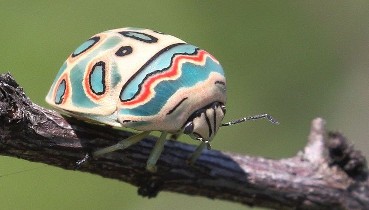 Picasso Bug aka Sphaerocoris annulus39 views
Picasso Bug aka Sphaerocoris annulus39 views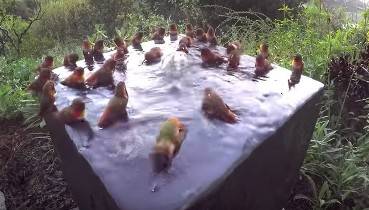 Flock Of Hummingbirds Gather In Bird Bath For A Mini Pool Party83 views
Flock Of Hummingbirds Gather In Bird Bath For A Mini Pool Party83 views-
Advertisements
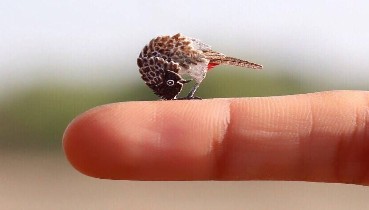 We Are Creating Miniature Paper Cut Birds Everyday For An Entire Year1030 views
We Are Creating Miniature Paper Cut Birds Everyday For An Entire Year1030 views Secret Tiled Staircase In San Francisco, California537 views
Secret Tiled Staircase In San Francisco, California537 views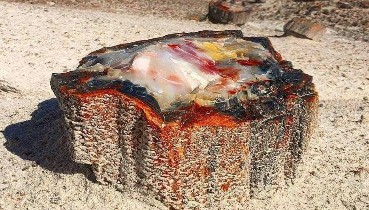 Petrified Tree Trunk in Arizona is 225 Million Years Old172 views
Petrified Tree Trunk in Arizona is 225 Million Years Old172 views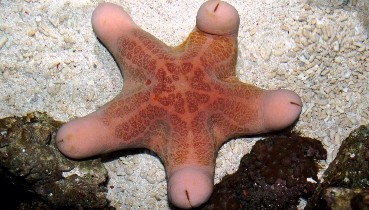 Meet the 50 Weirdest Deep Sea Creatures Lurking Beneath the Waves282 views
Meet the 50 Weirdest Deep Sea Creatures Lurking Beneath the Waves282 views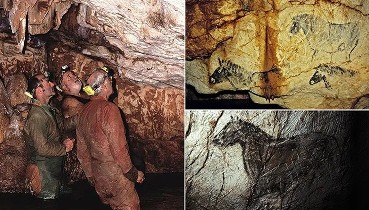 Cosquer Cave: Only Known Underwater Cave From The Stone Age23 views
Cosquer Cave: Only Known Underwater Cave From The Stone Age23 views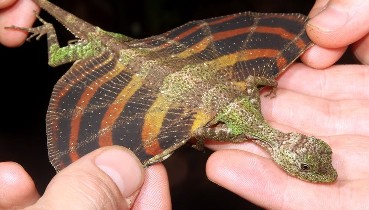 Five-lined flying dragon100 views
Five-lined flying dragon100 views





































